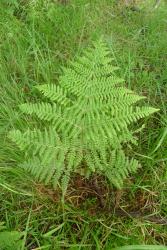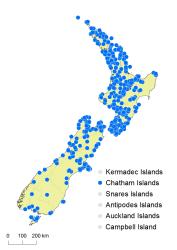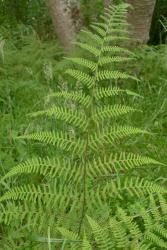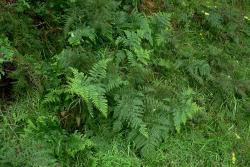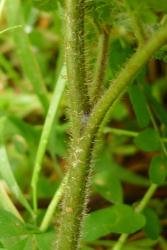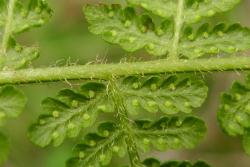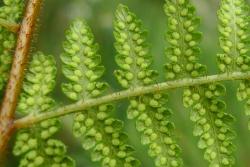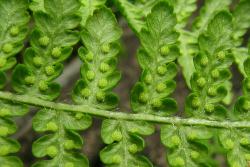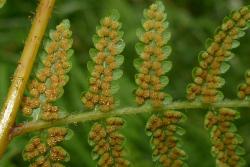- ≡ Cheilanthes ambigua A.Rich., Essai Fl. Nouv.-Zél., 84 (1832)
- = Polypodium amplum Colenso, Trans. & Proc. New Zealand Inst. 24: 396 (1892) nom. illeg., non Polypodium amplum Willd. 1810
- = Hypolepis petrieana Carse, Trans. & Proc. New Zealand Inst. 50: 64 (1918)
Rhizomes long-creeping, 2–4 mm diameter, with stipes arising 20–200 mm apart; bearing multicellular, non-glandular, red-brown hairs up to 3 mm long. Fronds 210–1850 mm long. Stipes 40–920 mm long, 1–6 mm diameter, red-brown or chestnut-brown proximally, usually becoming chestnut-brown or yellow-brown distally but rarely red-brown throughout, bearing abundant multicellular non-glandular red-brown hairs up to 3 mm long proximally, but sparser and paler distally. Rachises usually chestnut-brown or yellow-brown proximally, becoming yellow-green or green distally, rarely red-brown becoming chestnut-brown, sparsely covered in pale brown or red-brown hairs up to 2 mm long. Laminae deeply 2-pinnate-pinnatifid to deeply 3-pinnate-pinnatifid, narrowly ovate to broadly ovate, tapering to a pinnatifid apex, 135–1200 mm long, 90–1200 mm wide, light green on both surfaces, herbaceous or coriaceous; glistening colourless non-glandular hairs on abaxial lamina surface and costae but absent from lamina margin, 0.3–1 mm long; pale brown hairs on costae up to 2 mm long; glandular hairs rarely present on developing fronds. Primary pinnae in 17–30 pairs below pinnatifid apex, widely spaced proximally, overlapping distally, narrowly winged distally, the proximal pair arising at 20–50° to rachis; distal primary pinnae narrowly oblong or narrowly ovate; proximal primary pinnae ovate or broadly ovate; the longest at or near the base, 47–620 mm long, 30–350 mm wide, apices acute or acuminate, bases short-stalked. Secondary pinnae decreasing in length along primary pinnae to the distal end, winged throughout; the longest narrowly ovate or narrowly oblong, 17–235 mm long, 7–90 mm wide, apices acute or acuminate, bases short-stalked. Tertiary pinnae narrowly ovate or oblong, 4–62 mm long, 2–16 mm wide, apices obtuse, bases adnate, deeply divided on larger fronds into ultimate segments 2.5–9 mm long, 1.5–5 mm wide. Veins ending in apices of ultimate segments. Sori ± round, protected by slightly reflexed green lamina flaps bearing a few short hairs; paraphyses sometimes present, 0.3–0.5 mm long. Mean spore size 36–41 μm long, 22–28 μm wide; perispores pale, echinate and reticulate.
Note: measurements given above are from herbarium specimens. Larger fronds sometimes occur in the wild. WELT P020820 comprises parts of a frond that was said to measure 2500 mm long, with the lamina 1700 mm long and 1300 mm wide, and the largest primary pinna 900 mm long and 420 mm wide.
Hypolepis ambigua is one of two Hypolepis species in New Zealand that lacks glandular hairs. It is distinguished from Hiya distans by its veins, which reach the margin at an apex rather than a sinus; by its distal pinnae, which arise at an acute angle to the rachis rather than at right angles; and by its stipes, which are much thicker (1–6 cf. 0.75–1.25 mm diameter). It is similar to H. millefolium but can be recognised by its larger fronds (up to 1200 mm long and 1200 mm wide, cf. 770 mm long and 400 mm wide), and by the broader ultimate segments (more than 1 mm wide cf. less than 1 mm wide). The two are also often ecologically separated, H. ambigua being more common in lowland sites, whereas H. millefolium generally occurs at higher elevations. Hypolepis ambigua is morphologically similar to H. dicksonioides, the two often growing together in thermal areas, but H. ambigua can be distinguished by its lack of glandular hairs, more slender stipes (1–6 cf. 2–15 mm diameter), and lack of well-developed indusia.
North Island: Northland, Auckland, Volcanic Plateau, Gisborne, Taranaki, Southern North Island.
South Island: Western Nelson, Sounds-Nelson, Marlborough, Westland, Canterbury, Otago, Southland, Fiordland.
Three Kings Islands, Chatham Islands, Stewart Island.
Altitudinal range: 0–900 m.
Hypolepis ambigua occurs in lowland and montane areas throughout the North Island from Te Paki southwards, although apparently it is uncommon on the east coast around Gisborne. It ranges from near sea level to over 900 m in the Tongariro and Urewera National Parks. It occurs in lowland parts of much of the South Island, reaching 900 m at Jordan Stream, Marlborough, but is apparently absent from most of Fiordland. It also extends to the Chatham Islands and Stewart Island.
The species has naturalised on the island of Bute in Scotland (Hannah 2017).
Grows in open forest and forest clearings, on forest margins, in scrub and open grassland, under conifer plantations and willows, on river banks and alluvial flats, on sandy soils, roadsides, tracksides, in drainage ditches, and bordering lakes, swamps, peat bogs and thermally heated streams. In forest situations it prefers disturbed soils and rotten logs, and in open areas it often grows with bracken. It can form extensive colonies spreading by means of its rapidly growing rhizomes, and may also grow as a weed in gardens.
There is evidence for hybridisation between H. ambigua and H. dicksonioides (AK 266639, CHR 212707, WELT P011525), H. lactea (AK 298766–298767), H. millefolium (WELT P011837) and H. rufobarbata (AK 170251, CHR 280735, WELT P011530). Hybrids can be recognised by their aborted spores (see Brownsey & Chinnock 1984). The combination H. ambigua × rufobarbata is found commonly where the two species occur together, whilst H. ambigua × dicksonioides arises frequently in thermal areas.
n = 104 (Brownlie 1954, 1957, as H. tenuifolia; Brownlie 1961, as H. punctata; Brownsey & Chinnock 1984).
In New Zealand this species has been widely misidentified by earlier authors as either Hypolepis tenuifolia (G.Forst.) Bernh. ex C.Presl or Hypolepis punctata (Thunb.) Mett.
Hypolepis ambigua is morphologically very similar to H. polypodioides, a species which occurs from north-west India through southern China to the Philippines, peninsular Malaysia, Java and Flores (Brownsey 1987). Given the large distance between the distributions of the two species, it would be surprising if they were conspecific, but the possibility deserves further investigation.



